
snowboard binding size guide
This guide helps snowboarders choose the right binding size for optimal performance and comfort, ensuring compatibility with boots and snowboard width for a perfect fit.
Importance of Proper Binding Size
Proper binding size is crucial for optimal control, responsiveness, and comfort while snowboarding. Ill-fitting bindings can hinder performance, causing poor energy transfer and reduced maneuverability. Correct sizing ensures your boots fit securely, preventing excessive movement that can lead to fatigue or even safety issues. Properly sized bindings enhance stability, allowing precise control over the snowboard. They also maintain consistent performance across various snowboarding styles, ensuring a safer and more enjoyable experience on the mountain.
Overview of Binding Size Charts
Binding size charts provide a standardized guide to help riders match their boot size to appropriate binding sizes. Typically categorized into ranges like Small, Medium, Large, and Extra-Large, these charts offer a consistent reference across brands. They simplify the selection process, but individual variations in boot and binding designs may necessitate adjustments. It’s advisable to try bindings on and seek professional advice to ensure the best fit for optimal performance and comfort.
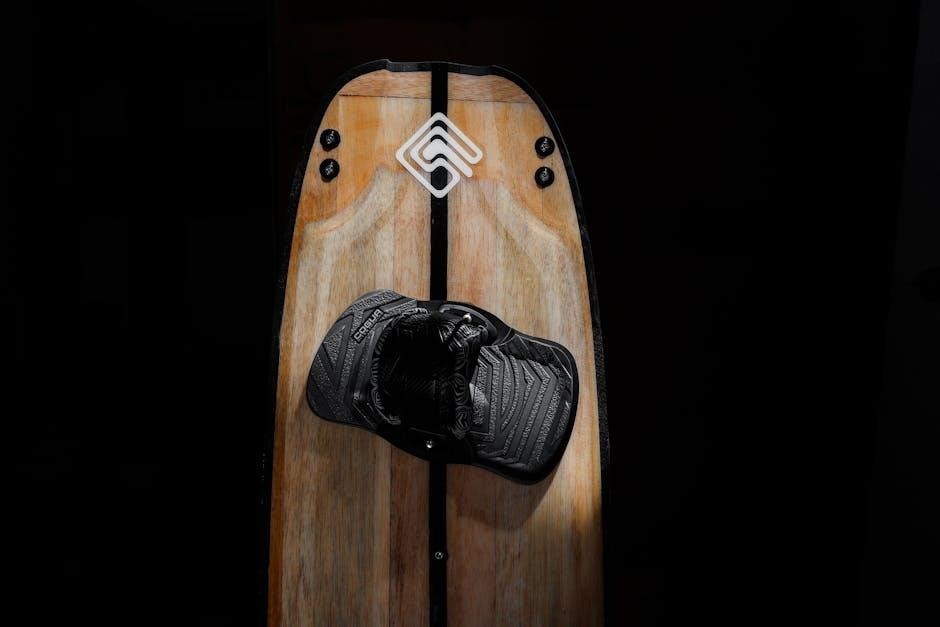
Understanding Boot and Binding Compatibility
Boot and binding compatibility is crucial for optimal performance and comfort. Proper fit ensures efficient energy transfer, responsiveness, and control while riding.
How Boot Size Relates to Binding Size
Boot size directly influences binding size. Proper fit ensures optimal control, comfort, and prevents issues like poor responsiveness or discomfort. Binding sizes correspond to boot sizes, typically categorized as Small, Medium, or Large, each fitting specific boot size ranges. For example, Small bindings may suit boot sizes 6-8. Always refer to manufacturer charts for accurate fitting, as preferences can vary. A well-matched setup enhances performance and enjoyment on the snow, making every ride more enjoyable.
Measuring Boot Size Accurately
Accurate boot measurement is crucial for proper binding fit. Use a Brannock device or trace your foot on paper to determine length and width. Try boots with the same socks you’ll ride with, as thickness affects fit. Ensure your heel-to-toe length aligns with the boot’s internal measurements. Stand up to check if your toes have enough room without excessive space. This ensures a snug, responsive fit, critical for performance and comfort on the snow.
Choosing the Right Binding Size
Selecting the correct binding size ensures optimal comfort, control, and performance. Properly sized bindings align with your boot size and snowboard width, enhancing responsiveness and stability. Always refer to size charts and consider your riding style to make an informed decision, ensuring a seamless connection between you, your boots, and the snowboard.
Binding Size Ranges (S-XL)
Binding size ranges typically categorize from Small (S) to Extra-Large (XL), corresponding to boot sizes. Small bindings fit boot sizes 6-8, Medium for 8-10, Large for 10-12, and XL for 12+. These ranges ensure proper fit and responsiveness. However, sizes vary slightly by brand, so always check the manufacturer’s chart. Properly sized bindings enhance control and comfort, while ill-fitting ones can hinder performance. Choose a size that aligns with your boot size and riding style for optimal results.
Factors Influencing Binding Size Selection
Several factors influence binding size selection, including boot size, riding style, and personal comfort. Boot size is the primary determinant, but riding style also plays a role—freestyle riders may prefer tighter bindings, while all-mountain riders might opt for a slightly looser fit. Additionally, snowboard width and brand-specific sizing can affect the ideal binding size. Always consider these elements to ensure a balanced setup that enhances performance and comfort on the slopes.
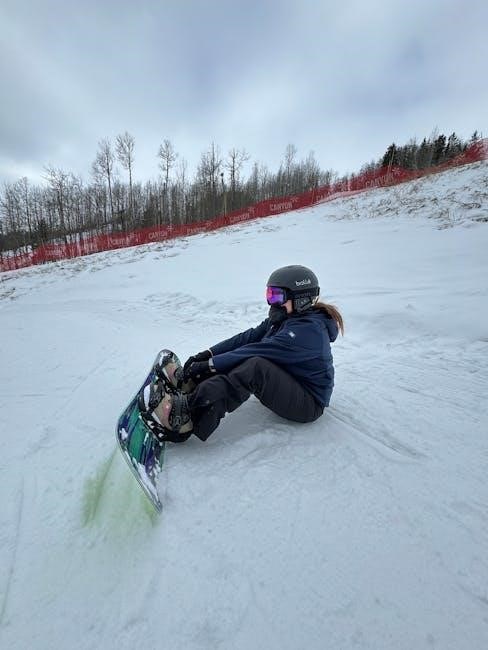
Snowboard Width and Binding Fit
Snowboard width impacts binding fit, crucial for compatibility and efficiency, ensuring optimal performance and control. Proper sizing is essential for balance and maneuverability.
Matching Binding Size to Snowboard Width
Properly matching binding size to snowboard width ensures optimal performance and control. Start by considering the snowboard’s waist width, which typically ranges from 23.5cm to 26.5cm, designed to accommodate different boot sizes and riding styles. Binding size charts often categorize sizes as S, M, L, and XL, corresponding to boot sizes. Ensure the binding size aligns with the snowboard’s waist width for a precise fit. Adjustable bindings offer flexibility across various snowboard widths, while less adjustable bindings require a more exact match. Riding style also influences this pairing: freestyle riders may prefer a different binding size relative to snowboard width compared to all-mountain riders. Additionally, check the mounting system compatibility, as most snowboards have specific patterns that bindings must fit. Consider the correlation between boot size, binding size, and snowboard width for balanced performance. Flex is another factor—softer bindings suit narrower boards, while stiffer bindings work better with wider ones. Brand and model compatibility should be verified, as sizing standards can vary. Stance width affects how bindings fit on the board, and personal preference may lead some riders to opt for a tighter or looser fit. Utilize available tools, such as charts or calculators, to help determine the best fit. Ultimately, the combination of these factors ensures the best match for optimal performance and comfort.
Width Requirements for Different Riding Styles
Different riding styles demand specific snowboard widths for optimal performance. Freestyle riders often prefer narrower boards (23.5cm–24.5cm) for agility and trick maneuverability. All-mountain riders benefit from medium widths (24.5cm–25.5cm) for versatility across various terrains. Powder riders opt for wider boards (25.5cm+) to float effortlessly in deep snow. Binding size must align with these widths to ensure proper fit and responsiveness. Always match your riding style with the appropriate snowboard width for enhanced control and performance.

Riding Style and Binding Size
Riding style significantly influences binding size selection. Freestyle riders may prefer more responsive bindings, while all-mountain riders might opt for a balanced fit. Ensure your bindings match your riding preferences for optimal performance.
Freestyle vs. All-Mountain Binding Sizes
Freestyle riders often prefer smaller, more flexible bindings for easier maneuverability and tricks, while all-mountain riders may opt for larger, stiffer bindings for stability and control. Binding size should align with your riding style to ensure responsiveness and comfort. Freestyle bindings focus on tweakability and boot compatibility, whereas all-mountain bindings emphasize durability and support for varying terrain. Consider your primary riding discipline to select the appropriate size and flex for optimal performance.
Adjusting Binding Size for Specific Disciplines
Adjusting binding size for specific disciplines ensures optimal performance. Freestyle riders may prefer smaller bindings for nimble control, while all-mountain riders benefit from larger bindings for stability. Powder riders often opt for slightly larger sizes to handle deep snow. Consider terrain demands and personal comfort when fine-tuning. Proper adjustments enhance responsiveness and ensure compatibility with boots, crucial for precise control in any discipline. Always test adjustments to confirm they meet your riding needs.
Adjustability and Fit Customization
Adjustability ensures a tailored fit, with features like straps, highbacks, and forward lean allowing customization to boot size and riding style for enhanced comfort and performance.
Adjustable Features in Bindings
Snowboard bindings often feature adjustable components like straps, highbacks, and forward lean to customize fit and responsiveness. Straps can be tightened or loosened to accommodate boot sizes, while highbacks adjust to support different calf muscle lengths. Forward lean settings allow riders to fine-tune edge control and riding posture. These adjustments ensure optimal comfort, performance, and compatibility with various boot sizes and riding styles, making bindings versatile for diverse snowboarders.
Customizing Fit for Optimal Performance
Customizing your snowboard binding fit enhances comfort and control. Start by ensuring boots fit snugly, with no excessive movement. Adjust straps to evenly distribute pressure without restricting ankle movement. Fine-tune highback angles to match your calf height and riding style. Properly align the binding system with the snowboard’s center for balanced weight distribution. These adjustments ensure a responsive, comfortable setup tailored to your needs, improving overall performance on the slopes.
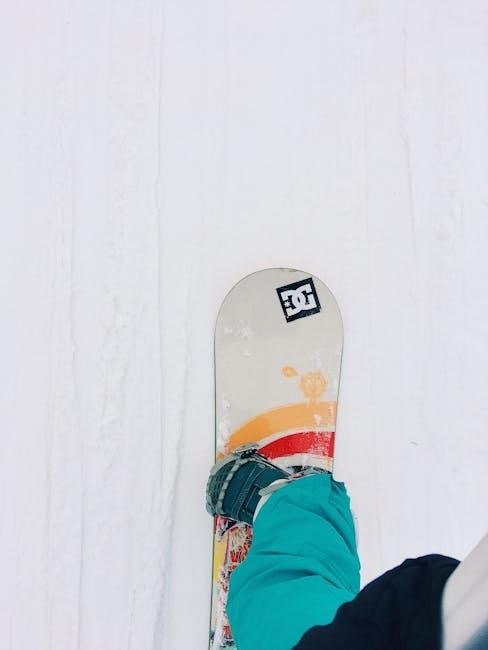
Binding Compatibility with Snowboard Models
Ensure bindings are compatible with your snowboard model by checking mounting systems, size, and flexibility. Proper compatibility guarantees optimal performance and safety on the slopes.
Ensuring Compatibility with Your Snowboard
To ensure compatibility, check your snowboard’s mounting system and binding size. Most bindings fit standard mounting patterns, but some models may require specific adapters. Verify that the binding size matches your snowboard’s width and riding style. Consult the manufacturer’s compatibility chart or seek advice from a professional to avoid mismatches. Proper fit ensures optimal responsiveness, control, and safety while riding. Always test compatibility before finalizing your setup for the best performance on the slopes.
Mounting Bindings on Different Snowboard Types
Mounting bindings varies slightly depending on the snowboard type. All-mountain and freestyle boards typically use standard mounting patterns, while powder boards may require offset or wider spacing. Adjustable baseplates allow customization for different snowboard widths. Always follow the manufacturer’s instructions for specific models. Proper alignment ensures even weight distribution and optimal performance. Double-check the mounting holes and adjust bindings to fit your riding style for a secure and responsive setup.
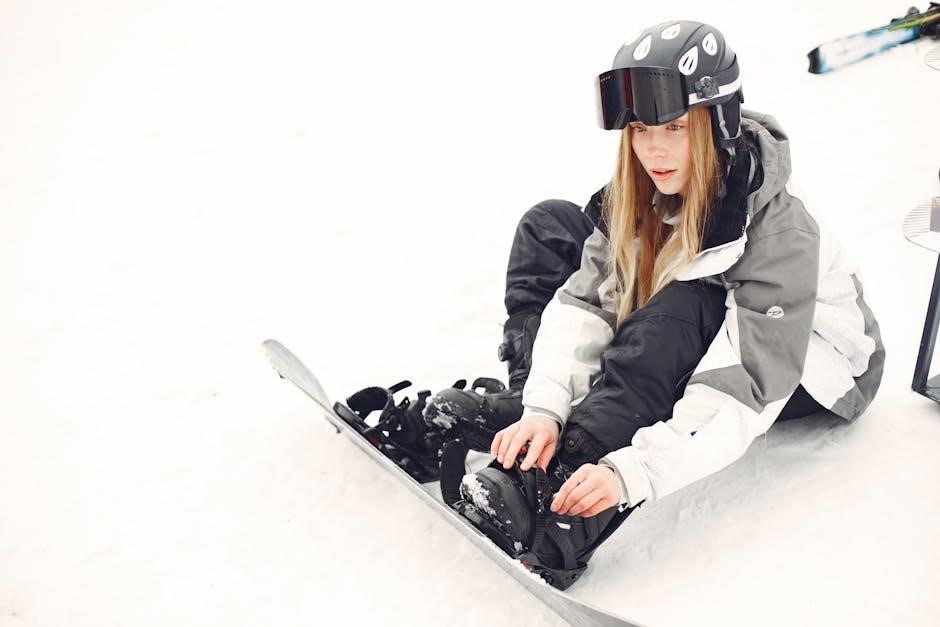
Flex and Responsiveness in Bindings
Binding flex and responsiveness are crucial for performance, with stiffer bindings offering precise control and softer ones providing flexibility for tricks. Materials and weight influence this.
Understanding Binding Flex Ratings
Binding flex ratings indicate how rigid or flexible a binding is, typically scored on a 1-10 scale. Softer bindings (1-3) suit freestyle and beginners, offering forgiveness. Stiffer bindings (7-10) are ideal for all-mountain or high-speed riding, providing precise control. The right flex matches your weight, riding style, and boot stiffness. Lighter riders may prefer softer bindings, while heavier riders benefit from stiffer ones. Proper flex ensures optimal performance and responsiveness, balancing comfort and control for your snowboarding needs.
Balancing Flex with Boot and Snowboard Flex
To optimize performance, ensure your bindings’ flex aligns with your boots and snowboard. A stiff snowboard pairs best with stiff boots and bindings for high-speed control, while softer setups suit freestyle riding. Lighter riders may prefer a softer flex combination for easier maneuverability, while heavier riders benefit from stiffer setups for responsiveness. Balancing flex across all components ensures smooth energy transfer, preventing poor edge hold or lack of pop. Proper alignment enhances overall riding efficiency and control.

Snowboard Binding Size Chart
A snowboard binding size chart maps boot sizes to binding sizes, ensuring proper fit. It’s a quick reference for riders to match their boot size with the right binding size across various brands and models.
Standard Size Charts for Boots and Bindings
Standard size charts categorize bindings as Small, Medium, or Large, correlating with boot sizes. For example, Small bindings fit boot sizes 6-8, Medium 8-10, and Large 10-12. Charts vary slightly by brand but generally align boot length (in centimeters) to binding size. Riders should measure their boots accurately and cross-reference with the manufacturer’s chart to ensure a proper fit. These charts are essential for matching boot and binding sizes, ensuring optimal performance and comfort on the snowboard.
Using the Chart to Find Your Perfect Fit
To use the chart effectively, start by measuring your boot size accurately. Align your boot length (in centimeters) with the corresponding binding size on the chart. Consider your riding style—loose or tight—and adjust accordingly. Cross-reference with the manufacturer’s specific guidelines, as slight variations exist. Ensure compatibility by checking the chart’s recommendations for your boot and binding combination. Test the fit before riding to confirm comfort and performance.
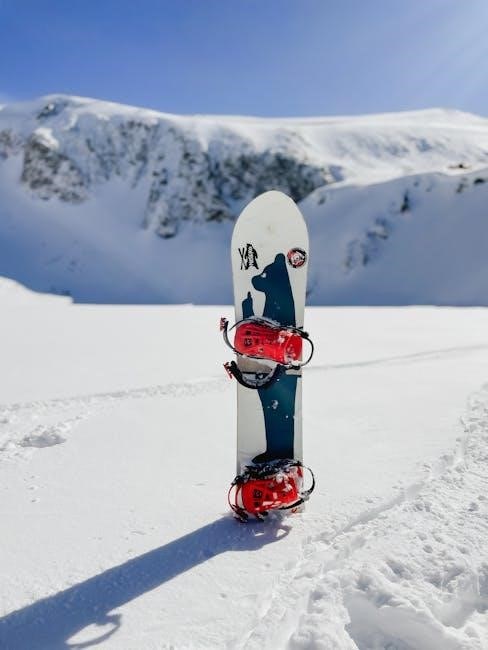
Used Bindings: Assessing Fit and Size
Assessing used bindings requires inspecting their condition, testing fit with your boots, and ensuring compatibility with your snowboard’s width and hole pattern for a secure mount.
How to Determine Used Binding Size
To determine the size of used snowboard bindings, start by comparing them with your boot size using a compatibility chart. Ensure they fit your snowboard’s width and mounting system. Inspect for wear and check adjustability. Consider the flex and seek advice from experienced sources if needed. Testing the fit with your boots and board can confirm proper sizing and ensure optimal performance.
Checking Compatibility with Your Setup
Ensuring your used bindings are compatible with your snowboard and boots is crucial for performance and safety. Check the binding’s mounting system to confirm it matches your board’s pattern, such as 2×4, 4×4, or channel systems. Verify the bindings fit your boot size and snowboard width. Consult compatibility charts or seek advice from experts if unsure. Testing the setup on the snowboard and with your boots will confirm proper alignment and functionality.
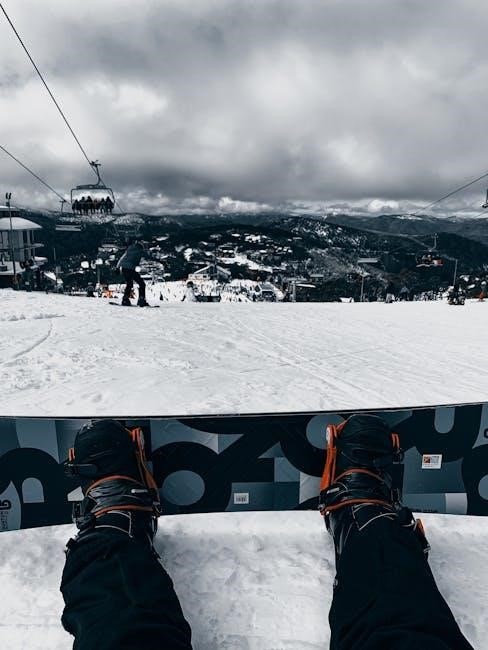
Maintenance and Setup Tips
Regularly clean and lubricate bindings to maintain performance. Tighten all screws and adjust straps for a secure fit. Ensure proper highback alignment for optimal responsiveness.
Adjusting Bindings for Seasonal Use
Inspect bindings before each season for wear and tear. Clean and lubricate moving parts to prevent rust. Adjust straps and highbacks to fit your boots snugly. Reset forward lean to match your riding stance. Ensure baseplates are securely mounted and aligned with your snowboard’s insert pattern. For varying snow conditions, slightly adjust binding angles or mounting positions to optimize performance. Store bindings dry during off-season to maintain functionality and longevity.
Maintaining Binding Performance Over Time
Regularly clean bindings with mild detergent to remove dirt and grime. Lubricate hinge systems and moving parts annually to ensure smooth operation. Inspect straps, ratchets, and padding for wear. Replace worn-out parts promptly to avoid performance loss. Store bindings in a cool, dry place during off-season to prevent rust. Check and tighten all screws before each use to maintain stability. Proper care ensures consistent responsiveness and longevity of your snowboard bindings.

Troubleshooting Common Fit Issues
Identify issues like snug boots causing discomfort or loose bindings affecting control. Adjust straps tightly and ensure proper baseplate alignment. If problems persist, consider resizing bindings for optimal performance and comfort.
Identifying and Resolving Fit Problems
Common fit issues include boot size mismatch, poor baseplate alignment, or strap tension imbalances. If boots are too large or small for bindings, performance suffers. Check for proper boot centering and ensure straps aren’t overly tight, causing discomfort. Address issues like toe drag or heel lift by adjusting highbacks or baseplate stance. For persistent problems, consult size charts or seek professional help to ensure optimal fit and responsiveness. Proper adjustments can prevent control loss and enhance riding comfort.
When to Consider a Different Binding Size
If your bindings consistently cause discomfort, impair performance, or struggle to hold your boots securely, it may be time to reassess your size. Signs like excessive toe or heel movement, difficulty controlling the board, or frequent foot pain indicate a poor fit. Upgrading to a larger or smaller size can enhance responsiveness and comfort. Always cross-reference your boot size with the binding’s size chart to ensure compatibility and optimal performance on the slopes.
Properly fitted bindings are essential for peak performance and safety. Invest time in selecting the right size to enhance your snowboarding experience and enjoyment on the slopes.
Final Tips for Choosing the Right Binding Size
Always consult a size chart and try bindings with your boots for the best fit. Consider your riding style and ensure compatibility with your snowboard. Don’t hesitate to seek professional advice for optimal performance and comfort. Regularly adjust your bindings to accommodate boot wear and ensure responsiveness. Remember, the right fit enhances control, safety, and overall enjoyment on the slopes.